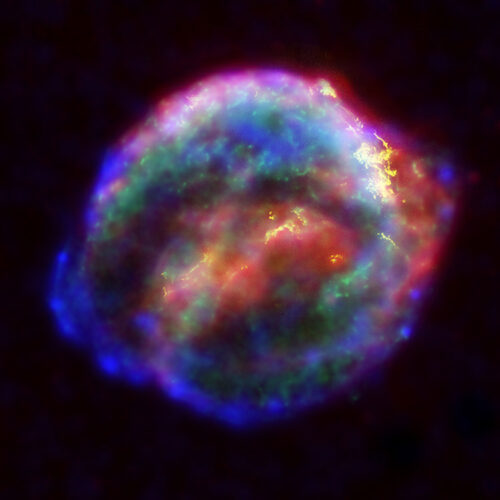The universe is expanding too quickly to fit theories. From Scope, the blog of the Yale Scientific Magazine.
Writing the biography of the universe is an epic undertaking. How can one story capture its growth from an infinitesimal point to a dense soup of plasma and, finally, to the vast, cold expanse we see today, laced with filaments of galaxies? With each new chapter, the universe expands, making the expansion rate a key throughline in the plot.
Troublingly, even after honing our best tools for studying the universe, there’s a discrepancy between the expansion rate measured using observational techniques and what we expect from our best models of cosmology. The story of our universe has a massive plot hole.
In The Astrophysical Journal Letters, Duke University physics professor Daniel Scolnic and his team recently published another piece of evidence suggesting that the cosmological distance ladder—a collection of techniques for measuring the distance to a star or galaxy—is struggling to bridge the gap between measurements of the very early universe and now. Scolnic studies the nearby universe for clues on our cosmological past. His team’s new paper adds to the body of evidence suggesting that the actual expansion rate of the universe might not match with our best models of cosmology.
Space is so vast that even light takes considerable time to travel to us—sometimes millions or billions of years. As a result, when telescopes observe distant objects, they are essentially looking back in time, viewing distant objects as they appeared in the past rather than as they are today. Researchers use clever measurements of stars and supernovae that shine with a known brightness to find out how far away those objects are. By collecting data across different distances and, therefore, times, researchers have been able to calculate the expansion rate of the universe. Known as the Hubble constant, this expansion rate surprised twentieth-century astronomers because it showed that the universe’s rate of expansion was changing. Now that different methods of measuring cosmic distances yield different values for the Hubble constant, astronomers have sought to address the persistent discrepancy known as the Hubble tension.
To better understand this issue, researchers can reverse this logic: instead of using the distance to calculate the Hubble constant, they can use different versions of the Hubble constant to predict how far away a specific object should be. Scolnic compares the values of the Hubble Constant and predicts the distance from Earth to the nearby Coma galaxy clusters based on different versions of the constant. Other scientists had been hoping to find a way to measure the distance to the nearby Coma cluster in order to obtain a more comprehensive testing ground for the Hubble constant. “We realized [we] knew a way to measure the distance to the Coma cluster, and if we combined it with [data from other collaborations], then [we] could have kind of one of the best measurements of the expansion of the universe,” Scolnic said.
While a large team at the Dark Energy Spectroscopic Instrument (DESI) collected extensive distance data to use in Hubble constant calculations by studying the structure of early galaxies, Scolnic’s team applied an even broader approach. In addition to DESI data, the team focused on measuring distances to nearby objects, providing a more comprehensive measurement. These methods of finding the Hubble constant predict that the Coma cluster is 98.5 megaparsecs away—equivalent to about 321 million light-years.
Meanwhile, at the edge of how far back we can look at our universe is a wall of incredibly even radiation from when the universe was hot, small, uniformly distributed, and opaque. Before then, the universe was so dense that light could not travel further than the size of an atom. This cosmic microwave background, the first light we can see from the early universe, is used alongside the Lambda-CDM model, our best current cosmological model of the universe’s evolution, to arrive at a Hubble constant value that predicts the distance to Coma to be 111.8 megaparsecs. However, other measurements from the James Webb Telescope and the Hubble Telescope all claim the distance to Coma must be under one hundred megaparsecs. Even more telling, the discrepancies are extremely unlikely to be explained by randomness. In other words, our best model of cosmology has room for improvement.
These sorts of cracks in a model stimulate flurries of excitement among cosmologists. For a field studying how our universe grew, cosmology involves a substantial devotion to the refinement of simple physical models. “There’s very much a sense that the universe is kind of simple and explainable, and if you add too many ingredients, you lose sight of that,” Scolnic said. While astrophysicists require rigorous data analysis, precise instruments, and strict statistical models, they also have a desire for elegance. Elegance guides the belief that there is a continuous narrative, spoken by math and matter, from 13.8 billion years ago to now.
Within the flaws of our current cosmological model, new ideas are being tested by other scientists. Behind the Hubble constant and universal expansion are dark energy and dark matter, the difficult-to-detect majority of matter and energy in our universe according to cosmologists’ best calculations. “People are part of the five percent of matter, and we have eyes and ears, and […] all this complexity. But what we assume for dark energy which makes up seventy percent is, it’s precisely one exact thing, and that’s it,” Scolnic said. Our ignorance about the nature of dark matter and dark energy means that there could be a variety of complex phenomena at play behind the scenes. With more research, new opportunities to understand these fundamental components of the cosmos may emerge.
The expansion rate dictated by the Hubble constant is key to constructing a cohesive narrative of the universe. Thanks to new findings and ever more precise measurements, we know there might be new characters in the story.

